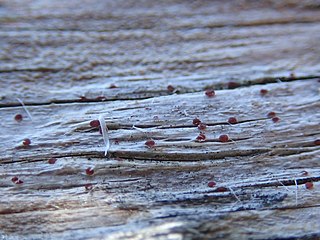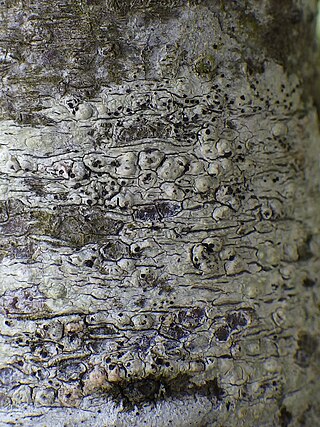Spegazzinia is a genus of widely distributed mitosporic ascomycete fungi in the family Didymosphaeriaceae.As accepted by Wijayawardene et al. 2020.

Agyrium is a genus of saprophytic fungi in the family Agyriaceae. It probably evolved from a lichen ancestor, as it is closely related to many lichenized species of fungi.
Scutula is a genus of lichenicolous fungi in the family Ramalinaceae.

Capnodiales is a diverse order of Dothideomycetes, initially based on the family Capnodiaceae, also known as sooty mold fungi. Sooty molds grow as epiphytes, forming masses of black cells on plant leaves and are often associated with the honeydew secreted by insects feeding on plant sap. This diverse order has been expanded by the addition of several families formerly thought unrelated and now also includes saprobes, endophytes, plant pathogens, lichens and rock-inhabiting fungi. The new additions include the genus Mycosphaerella containing the causal agents of several economically important crop and tree diseases. A small number of these fungi are also able to parasitise humans and animals, including species able to colonise human hair shafts.
Coppinsia is a genus of lichenized fungi in the family Trapeliaceae. This is a monotypic genus, containing the single species Coppinsia minutissima.
Thamnogalla is a fungal genus in the family Cordieritidaceae. It is a monotypic genus, containing the single lichenicolous species Thamnogalla crombii, found in Europe and North America. The genus was circumscribed in 1980 by David Leslie Hawksworth. The type species was originally described as Endocarpon crombiei by amateur botanist and collector William Mudd.
Combea is a genus of lichens in the family Opegraphaceae. It has two species. The genus was circumscribed by Italian botanist Giuseppe De Notaris in 1846.
Dolichocarpus is a genus of lichens in the family Opegraphaceae. The genus was circumscribed by lichenologist Rolf Santesson in 1949, with Dolichocarpus chilensis assigned as the type species. This species, found in Chile, grows on cactus spines in a fog desert. For several decades the genus remained monotypic, until 2008 when André Aptroot added Dolichocarpus seawardii. This lichen, found on St Helena, forms large patches on wet, overhanging rock ledges.
Caprettia is a genus of lichenized fungi in the family Monoblastiaceae. The genus was circumscribed by Augusto Chaves Batista and Heraldo da Silva Maia in 1965, with Caprettia amazonensis assigned as the type species.
Endococcus is a genus of lichenicolous (lichen-dwelling) in the family Lichenotheliaceae. It has 44 species. The genus was circumscribed by the Finnish botanist William Nylander in 1855. Although at least one source places the genus in the Verrucariaceae, a 2016 study of the type species, Endococcus rugulosus, determined that it should instead be placed in the family Lichenotheliaceae of the order Dothideales; this classification echoes a placement proposed in 1979 by David Hawksworth.
Oceanitis is a genus of marine fungi in the class Halosphaeriaceae. It has four species. The genus was circumscribed by mycologist Jan Kohlmeyer in 1977, with Oceanitis scuticella assigned as the type species.

Abrothallus is a genus of lichenicolous fungi. It is the only genus in the monotypic family Abrothallaceae, which itself is the sole taxon in the order Abrothallales.
Zwackhiomyces is a genus of lichenicolous fungi in the family Xanthopyreniaceae. The genus was circumscribed by Martin Grube and Josef Hafellner in 1990, with Zwackhiomyces coepulonus assigned as the type species.

Skyttea is a genus of lichenicolous (lichen-dwelling) fungi in the family Cordieritidaceae. The genus was circumscribed in 1981 by lichenologists Martha Allen Sherwood, David L. Hawksworth, and Brian J. Coppins, with Skyttea nitschkei assigned as the type species.

Ramonia is a genus of lichenized fungi in the family Gyalectaceae. It contains 24 species. The genus was circumscribed by Ernst Stizenberger in 1862.

Phacopsis is a genus of lichenicolous (lichen-dwelling) fungi. They are parasites of members of the large lichen family Parmeliaceae, of which they are also a member. Originally proposed by Edmond Tulasne in 1852 to contain 3 species, Phacopsis now contains 10 species, although historically, 33 taxa have been described in the genus. Many of the species are poorly known, some of them having been documented only from the type specimen.

Ovicuculispora is a genus of lichenicolous fungi in the family Bionectriaceae. The genus was circumscribed by Javier Etayo in 2010, with O. parmeliae assigned as the type species. This species had formerly been placed in the genera Nectria in 1981, and later (2001) in Nectriopsis.

Cordieritidaceae is a family of fungi in the order Cyttariales. Species in this family are saprobes or lichenicolous.
Raesaenenia is a fungal genus in the large family Parmeliaceae. It is a monotypic genus, containing the single lichenicolous fungus Raesaenenia huuskonenii, which parasitises lichens of genus Bryoria in the Northern Hemisphere.

Robert Lücking is a German lichenologist. He earned his master's and PhD from the University of Ulm, focusing on the taxonomy, ecology, and biodiversity of foliicolous lichens. He has received numerous awards for his work, including the Mason E. Hale Award for his doctoral thesis, the Augustin Pyramus de Candolle prize for his monograph, and the Tuckerman Award twice for his publications in The Bryologist. Since 2015, he has been serving as the curator of lichens, fungi, and bryophytes at the Berlin Botanical Garden and Botanical Museum, and several lichen species and a genus have been named in his honour.








